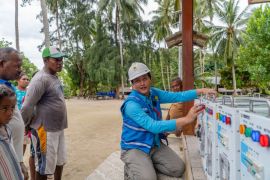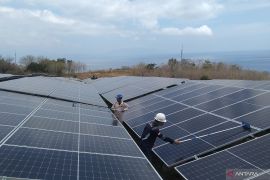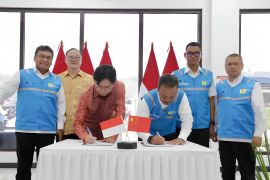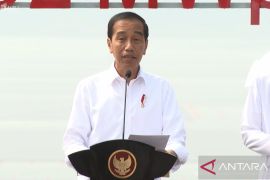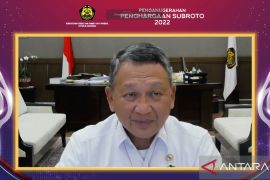Scientific analysis shows that the adverse effects of climate change can be avoided by keeping the global temperature rise to no more than two degree Celsius and closer to 1.5 degree Celsius as compared to pre-industrial times.
To avoid those effects of climate change, world leaders agreed through the United Nations to the adoption of the Paris Agreement in 2015 that the rate of greenhouse gas emissions must be reduced as low as possible and reach net-zero emissions (NZE) by the second half of the mid-20th century.
It is close to zero and the remaining emissions can be absorbed by the land and forest system or technology, such as carbon capture and storage, so the net emissions become zero.
The Government of Indonesia (GoI) ratified the Paris Agreement (PA) and submitted its commitment to reduce greenhouse gas emissions with an unconditional target of 29 percent and conditional target, with international support, of 41 percent as compared to business as usual (BAU) emission levels by 2030.
The Indonesian government has conveyed a long-term vision to develop a climate-resilient low-carbon development pattern in line with the Paris target called the Low Carbon Compatible with the Paris Agreement target (LCCP) scenario.
Related news: Encouraging blended finance for energy transition through G20
In this scenario, greenhouse gas emissions will reach a peak of 1,240 million tons of CO2e by 2030 and then gradually decline to reach 540 million tons of CO2e in 2050. It is expected that NZE will be achieved by 2060 or earlier
Developing new and renewable energy (EBT) becomes important for reducing greenhouse gas emissions in the energy sector and realizing NZE by 2060.
At the COP26 in 2021, Indonesia highlighted its commitment to reducing greenhouse gas emissions, which the commitment emphasized that Indonesia will achieve NZE by 2060 or sooner.
Hence, efforts are deemed necessary to mitigate climate change by reducing the carbon intensity, or the process of decarbonization, while maintaining national energy security.
One mitigation measure that can play the most significant role in reducing greenhouse gas emissions in the energy sector is the development of EBT as a transition step towards cleaner, lower emission, and environmentally friendly energy.
Energy and Mineral Resources Minister Arifin Tasrif revealed that Indonesia has abundant renewable energy potential of around three thousand GW, with its geothermal potential pegged at 24 GW.
Related news: Only 0.3% of Indonesia's new, renewable energy potential utilized
Over the past five years, the capacity of new and renewable energy power plants has continued to be augmented, and it is currently recorded at 12 GW, with geothermal energy contributing 2.2 GW.
The potential of new and renewable energy will be utilized optimally to accelerate the energy transition process. In 2060, the target of power generation capacity of new and renewable energy is 700 GW from solar, hydro, wind, bioenergy, marine, geothermal, including hydrogen and nuclear.
Geothermal power generation is estimated to reach 22 GW, driven by new business schemes and technological innovations that are competitive and affordable, including deep drilling geothermal development, enhanced geothermal systems, and offshore geothermal development.
To accelerate and expand the use of geothermal energy as an energy source, the government has re-imposed tariffs on geothermal steam and electricity and proposed an easier process for permitting land use in conservation forests as well as provided exemption from land and building taxes, Tasrif stated.
Increasing and accelerating clean energy development requires various technologies and financial support from several entities, including governments, international organizations, financial institutions, businesses, and philanthropy.
Regarding access to the utilization of technology, it must be made more inclusive. Hence, access to technology and affordable financing must be explored massively, he said.
Currently, there are two financing schemes for geothermal development in Indonesia -- the Geothermal Energy Upstream Development Project and the Geothermal Resource Risk Mitigation -- being undertaken in collaboration with the Ministry of Finance, PT SMI, and the World Bank.
According to president of the Indonesian Geothermal Association (API), Prijandaru Effendi, geothermal could be a clean alternative and transitional energy source.
Geothermal is a clean, reliable, and sustainable energy source, which, if developed and managed properly, can be one of the important solutions in the national energy transition to support future energy security, he remarked.
Related news: Ministry continues community-based new, renewable energy development
He affirmed that the API will continue to push geothermal energy as the main energy source for ensuring the sustainability of national development for the realization of national energy independence and contributing to Indonesia's commitment to the Paris Agreement, which has been ratified by Law No. 16 of 2016.
Effendi emphasized that API is committed to increasing the use of geothermal energy as an energy source to 7.2 GW by 2025, 10 GW by 2030, and 17 GW by 2050, in accordance with the General National Energy Plan (RUEN).
Achieving geothermal utilization according to the target set in RUEN will not be easy, and it will require hard work and a concrete and realistic acceleration program. In this regard, API will help achieve these targets, but full support from the government will also be needed, so that the problems and challenges that exist today can be resolved soon, he emphasized.
Related news: Presidential regulation on EBT power tariffs expected this week
Related news: New, renewable energy power plants' installed capacity reaches 12 GW
Editor: Fardah Assegaf
Copyright © ANTARA 2022





